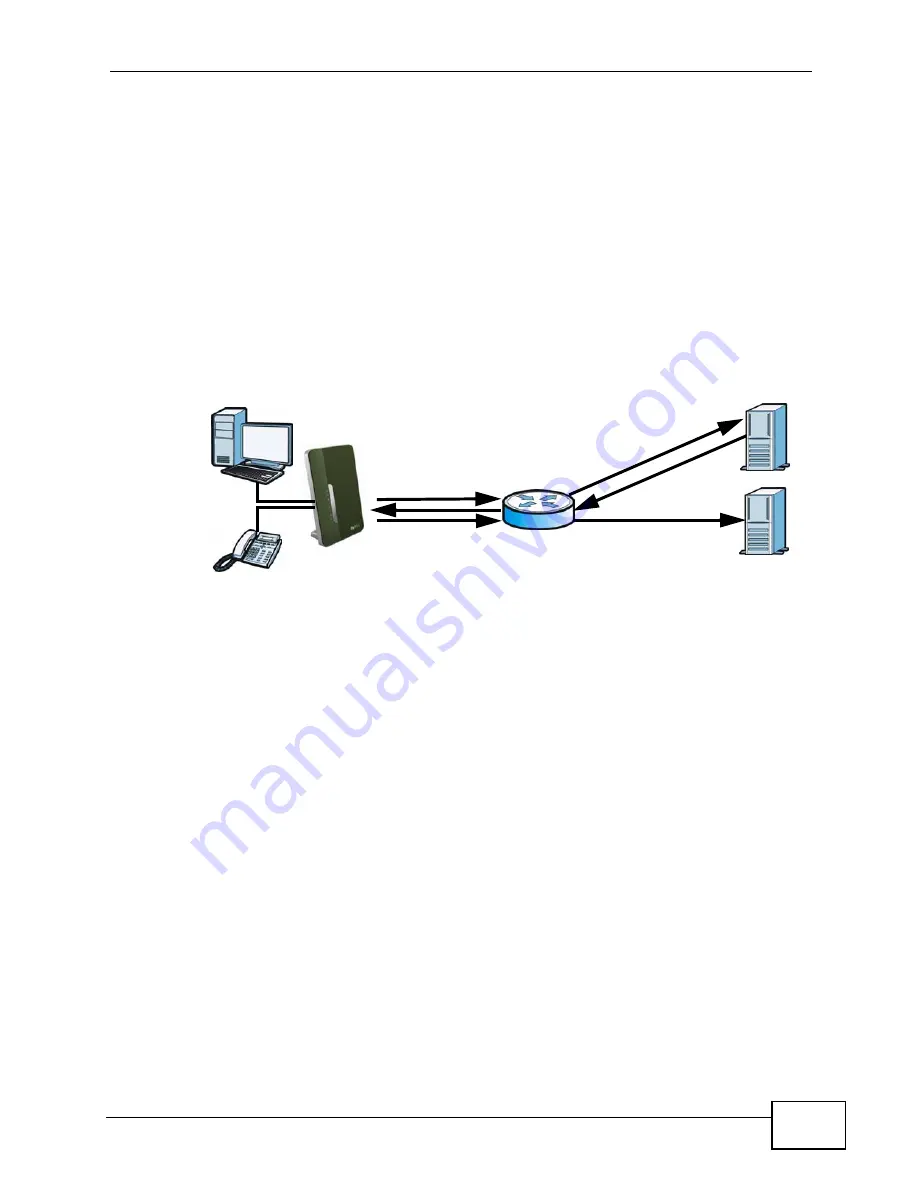
Chapter 10 The Service Configuration Screens
User’s Guide
113
Modem can embed it in the SIP data stream. STUN does not work with symmetric
NAT routers or firewalls. See RFC 3489 for details on STUN.
The following figure shows how STUN works.
1
The WiMAX Modem (A) sends SIP packets to the STUN server (B).
2
The STUN server (B) finds the public IP address and port number that the NAT
router used on the WiMAX Modem’s SIP packets and sends them to the WiMAX
Modem.
3
The WiMAX Modem uses the public IP address and port number in the SIP packets
that it sends to the SIP server (C).
Figure 45
STUN
10.2.1.2 Outbound Proxy
Your VoIP service provider may host a SIP outbound proxy server to handle all of
the WiMAX Modem’s VoIP traffic. This allows the WiMAX Modem to work with any
type of NAT router and eliminates the need for STUN or a SIP ALG. Turn off a SIP
ALG on a NAT router in front of the WiMAX Modem to keep it from re-translating
the IP address (since this is already handled by the outbound proxy server).
10.2.1.3 Voice Coding
A codec (coder/decoder) codes analog voice signals into digital signals and
decodes the digital signals back into voice signals. The WiMAX Modem supports
the following codecs.
• G.711 is a Pulse Code Modulation (PCM) waveform codec. PCM measures
analog signal amplitudes at regular time intervals (sampling) and converts them
into digital bits (quantization). Quantization “reads” the analog signal and then
“writes” it to the nearest digital value. For this reason, a digital sample is usually
slightly different from its analog original (this difference is known as
“quantization noise”). G.711 provides excellent sound quality but requires
64kbps of bandwidth.
A
B
C
NAT
1
Summary of Contents for MAX-207HW2
Page 7: ...Safety Warnings User s Guide 8...
Page 9: ...Contents Overview User s Guide 10...
Page 16: ...17 PART I Introduction and Wizards Getting Started 19 Introducing the Web Configurator 23...
Page 17: ...18...
Page 27: ...Chapter 2 Introducing the Web Configurator User s Guide 28...
Page 28: ...29 PART II Basic Screens The Main Screen 25 The Setup Screens 31...
Page 29: ...30...
Page 37: ...Chapter 3 The Setup Screens User s Guide 38...
Page 39: ...40...
Page 43: ...Chapter 4 The Status Screen User s Guide 44...
Page 57: ...Chapter 5 The LAN Configuration Screens User s Guide 58...
Page 75: ...Chapter 6 The WIFI Configuration Screen User s Guide 76...
Page 87: ...Chapter 7 The WAN Configuration Screens User s Guide 88...
Page 97: ...Chapter 8 The NAT Configuration Screens User s Guide 98...
Page 107: ...108...
Page 125: ...Chapter 10 The Service Configuration Screens User s Guide 126...
Page 141: ...Chapter 12 The Phone Book Screens User s Guide 142...
Page 143: ...144...
Page 147: ...Chapter 13 The Certificates Screens User s Guide 148...
Page 159: ...Chapter 14 The Remote Management Screens User s Guide 160...
Page 165: ...Chapter 16 The Status Screen User s Guide 166...
Page 166: ...167 PART VI Troubleshooting and Specifications Troubleshooting 169 Product Specifications 177...
Page 167: ...168...






























